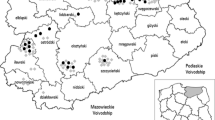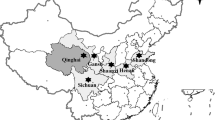Abstract
Giardiasis is one of the main diseases transmitted by food contaminated with infectious stages. It was usually spread through freshly eaten food. In this study, this parasite was diagnosed based on microscopic diagnosis of isolated samples of vegetables and fruits, as well as molecular diagnosis. The possibility of isolating parasites from vegetables and fruits and extract DNA to be used in most laboratories were verified in this study .The prevalence of Giardia lamblia were estimated on vegetables and fruits without the need to purchase a special extraction kit. .The prevalence of Giardia on fresh vegetables was estimated by using wet direct swab with Lugol’s iodine dye in microscopic examination, at a rate of 4 positive samples out of 230 of all studied species, or 1.7%. DNA extraction was carried out for all samples, and 102 DNA samples were extracted from all samples, with a percentage of 44.3%. Moreover, the shown results of the nested PCR test for the 16 S rRNA gene on the obtained DNA the prevalence of Giardia lamblia at a rate of 5.9% from DNA samples isolated from vegetables and fruits.



Similar content being viewed by others
References
Abdulwahhab IG (2021) Effect of Crataegus Azarolus Extracted in Treatment of Giardia Lamblia Infection. Indian Journal of Forensic Medicine & Toxicology, 15(2)
Ali SM, Mahnaz S, Mahmood T (2008) Rapid genomic DNA extraction (RGDE). Forensic Sci International: Genet Supplement Ser 1:63–65
Appelbee AJ, Frederick LM, Heitman TL, Olson ME (2003) Prevalence and genotyping of Giardia duodenalis from beef calves in Alberta, Canada. Vet Parasitol 112:289–294
Aziz SJ, Mahmoud OI (2020) diagnosis of protozoa and nematodes in stomach and intestine of sheep in Salah Al-Din Governorate. Tikrit J Pure Sci 25(6):10–15
Berrouch S, Escotte-Binet S, Harrak R, Huguenin A, Flori P, Favennec L, Villena I, Hafid J (2020) Detection methods and prevalence of transmission stages of Toxoplasma gondii, Giardia duodenalis and Cryptosporidium spp. in fresh vegetables: a review. 147:516–532Parasitology5
Efstratiou A, Ongerth JE, Karanis P (2017) Waterborne transmission of protozoan parasites: Review of worldwide outbreaks - An update 2011–2016. Water Research, [online] 114, pp.14–22. Available at: https://www.sciencedirect.com/science/article/pii/S004313541730043X?via%3Dihub
Domenech, E., Amorós, I., Moreno, Y. and Alonso, J.L. (2018). Cryptosporidium and Giardia safety margin increase in leafy green vegetables irrigated with treated wastewater. International Journal of Hygiene and Environmental Health, 221(1), pp.112–119
Fallah AA, Pirali-Kheirabadi K, Shirvani F, Saei-Dehkordi SS (2012) Prevalence of parasitic contamination in vegetables used for raw consumption in Shahrekord, Iran: Influence of season and washing procedure. 25:617–620Food Control2
FAO; WHO (2014) Multicriteria-based ranking for risk management of food-bornparasites, first. Microbiological Risk Assessment Series No. 23Rome. FAO/WHO,Rome
Feng Y, Xiao L (2011) Zoonotic Potential and Molecular Epidemiology of Giardia Species and Giardiasis. Clinical Microbiology Reviews, [online] 24(1), pp.110–140. Available at: https://cmr.asm.org/content/24/1/110 [Accessed 3 May 2019]
Giangaspero A, Gasser RB (2019) Human cyclosporiasis. 19:e226–e236The Lancet Infectious Diseases7
Hald T, Aspinall W, Devleesschauwer B, Cooke R, Corrigan T, Havelaar AH, Gibb HJ, Torgerson PR, Kirk MD, Angulo FJ, Lake RJ, Speybroeck N, Hoffmann S (2016) World Health Organization Estimates of the Relative Contributions of Food to the Burden of Disease Due to Selected Foodborne Hazards: A Structured Expert Elicitation. 11:e0145839PLOS ONE1
Hasan TAH, Muhaimid AKA, Mahmoud AR (2020) Epidemiological Study of Giardia lamblia in Tikrit city, Iraq. Systematic Reviews in Pharmacy, 11(9),102–106
Hernández-Arango N, Pinto V, Muñoz-Sanchez D, Lora-Suarez F, Gómez-Marín JE (2019) Detection of Giardia spp. with formalin/ether concentration in Brassica oleracea (cabbage) and Lactuca sativa (lettuce). 5:e02377Heliyon8
Hopkins, R.M., Meloni, B.P., Groth, D.M., Wetherall, J.D., Reynoldson, J.A, Thompson, R.C., (1997). Ribosomal RNA sequencing reveals differences between the genotypes of Giardia isolates recovered from humans and dogs living in the same locality. J. Parasitol. 83, 44–51
Ismail Y (2016) Prevalence of Parasitic Contamination in Salad Vegetables Collected from Supermarkets and Street Vendors in Amman and Baqa’a – Jordan. 65:201–207Polish Journal of Microbiology2
Istifanus W, Panda S (2018) Parasitic Agents in Fresh Fruits and Vegetables Sold in Open Markets in Bauchi, Nigeria. 5:84–88Journal of Food Quality and Hazards Conrol3
Jung Y, Jang H, Matthews KR (2014) Effect of the food production chain from farm practices to vegetable processing on outbreak incidence. 7:517–527Microbial Biotechnology6
Lanata CF, Fischer-Walker CL, Olascoaga AC, Torres CX, Aryee MJ, Black RE (2013) Global Causes of Diarrheal Disease Mortality in Children < 5 Years of Age: A Systematic Review. PLoS ONE, [online] 8(9), p.e72788. Available at: https://www.ncbi.nlm.nih.gov/pmc/articles/PMC3762858/ [Accessed 28 Mar. 2019]
Lebbad M (2010) Molecular Diagnosis and Characterization of two intestinal Protozoa: Entamoeba histolytica & Giardia intestinalis. Institutionen för mikrobiologi. tumör-och cellbiologi/Department of Microbiology, Tumor and Cell Biology
Li J, Wang Z, Karim MR, Zhang L (2020) Detection of human intestinal protozoan parasites in vegetables and fruits: a review. Parasites & Vectors, 13(1)
Maniatis T, Fritsch EF, Sambrook (2001) vitro Applications of DNA by the Polymerase Chain Reaction, in Molecular Cloning : A laboratory manual, 2nd edn. Cold Spring Harbor lab
Mercanoglu Taban B, Halkman AK (2011) Do leafy green vegetables and their ready-to-eat [RTE] salads carry a risk of foodborne pathogens? 17:286–287Anaerobe6
Moratal S, Dea-Ayuela MA, Cardells J, Marco-Hirs NM, Puigcercós S, Lizana V, López-Ramon J (2020) Potential Risk of Three Zoonotic Protozoa (Cryptosporidium spp., Giardia duodenalis, and Toxoplasma gondii) Transmission from Fish Consumption. Foods, 9(12), p.1913
Nguyen TT, Traub R, Pham PD, Nguyen HV, Nguyen KC, Phung CD, Dalsgaard A (2016) Prevalence and molecular characterization of Cryptosporidum spp. and Giardia spp. in environmental samples in Hanam province, Vietnam. Food and Waterborne Parasitology, 3,13–20
Ryan U, Hijjawi N, Xiao L (2018) Foodborne cryptosporidiosis. International Journal for Parasitology, [online] 48(1), pp.1–12. Available at: https://www.ncbi.nlm.nih.gov/pubmed/29122606 [Accessed 29 Oct. 2020]
Shields JM, Lee MM, Murphy HR (2012) Use of a common laboratory glassware detergent improves recovery of Cryptosporidium parvum and Cyclospora cayetanensis from lettuce, herbs and raspberries. 153:123–128International Journal of Food Microbiology1–2
Sleman Ali H, Mageed S, Jahed Khaniki G, Shariatifar N, Yunesian M, Rezaeian M, Saleh (2018) Kk. Contamination of Cryptosporidium spp. Oocysts in Raw Vegetables Produced in Koya City, Iraq. Journal of Food Quality and Hazards Conrol, 5(3), pp.89–93
Author information
Authors and Affiliations
Corresponding author
Additional information
Publisher’s Note
Springer Nature remains neutral with regard to jurisdictional claims in published maps and institutional affiliations.
Rights and permissions
About this article
Cite this article
Mozer, S., Abdulwahhab, I.G. & AL-Azaawie, A.F. Extraction of the DNA of Giardia lamblia isolated from vegetables and fruits in a simplified way and its diagnosis using Nested-PCR. J Parasit Dis 46, 771–775 (2022). https://doi.org/10.1007/s12639-022-01484-4
Received:
Accepted:
Published:
Issue Date:
DOI: https://doi.org/10.1007/s12639-022-01484-4




